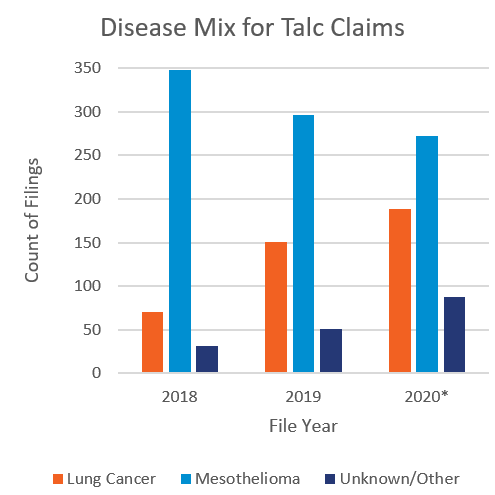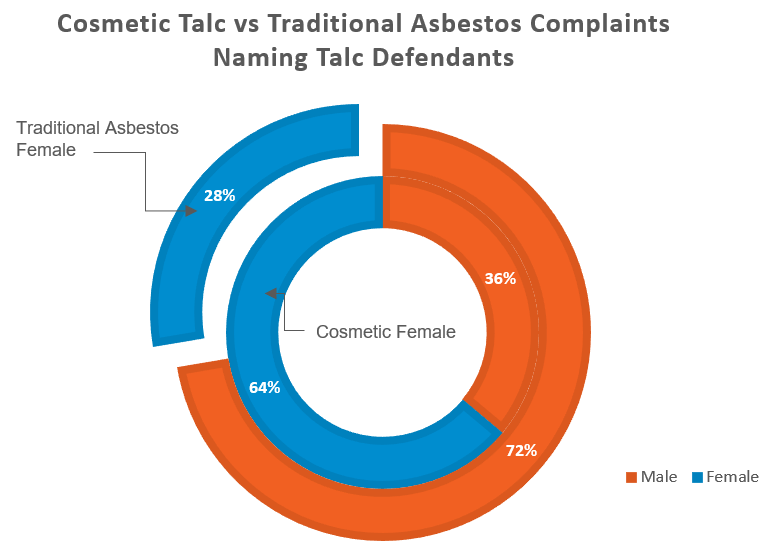
On May 13, Perrin held a webinar to discuss recent developments in the talc litigation landscape in 2020. The panel had a variety of speakers who covered a wide range of topics. Jim Kramer, from Simmons Hanly Conroy, explored how recent talc verdicts may affect future verdicts. Susan Valinis, from Reilly McDevitt Henrich, spoke about government efforts to coordinate and standardize talc testing. Amanda Webber, from Allianz Reinsurance America, Inc., discussed the insurance perspective in talc litigation. And lastly, KCIC’s Michelle Potter uncovered some key data insights that have been observed in talc filings over the last few years.
KCIC has a robust dataset of talc claims, which we compiled from both asbestos complaints alleging talc exposure from our normal claims administration processes and cosmetic only talc lawsuits from Blueprint Trial Consulting. The talc claims data Michelle presented, derived from this dataset, examined the rising number of lawsuits we are seeing. The number of talc claims filings increased 11% from 2018 to 2019 and we estimate 2020 talc claims filings will increase another 10%.
Another interesting trend Michelle dissected during her presentation was the changes in disease mix for talc claims. Mesothelioma cases have decreased from 77% of filings in 2018 to only 50% of filings projected for 2020. While conversely, Lung Cancer cases have risen from 16% of filings in 2018 to 34% of filings projected for 2020. This shift in disease distribution is most likely due to the change we have detected in the number of cosmetic only talc filings versus the number of traditional asbestos filings alleging talc exposure. In 2018 we observed that 33% of talc claim filings were cosmetic only talc filings, while in 2019 and 2020 cosmetic only talc filings decreased to 15%. The data revealed that cosmetic only talc filings are typically Mesothelioma claims, while traditional asbestos filings alleging talc exposure display a split between Mesothelioma and Lung Cancer claims. Since we are seeing an increase in the traditional occupational asbestos complaints alleging talc exposure, the data lends itself to suggest that there is a correlation between the rise in traditional asbestos complaints with talc exposure and the observed increase in Lung Cancer talc claims. The chart below illustrates the disease mix for talc claims over the last three years, clearly displaying the steady rise in Lung Cancer filings and the inverse trend for Mesothelioma filings.

Another observation in talc filings Michelle spoke about during the Perrin webinar was the plaintiff gender split between cosmetic only talc filings and traditional asbestos complaints alleging talc exposure. Out of all talc filings from 2018 – 2020, 60% were male plaintiffs while 40% were female plaintiffs. However, this male to female ratio drastically changes if we look at the gender split in cosmetic only talc filings versus the gender split in traditional asbestos complaints alleging talc exposure. Female plaintiffs composed a 64% majority of the cosmetic only talc filings but accounted for only 28% of the traditional asbestos complaints alleging talc exposure. This change in male to female ratio between cosmetic only talc filings and traditional asbestos filings alleging talc exposure is exemplified in the below graph.

As the remainder of 2020 unfolds, we will continue to analyze talc data trends as we receive filings throughout the rest of the year. If you are interested in watching a recording of the webinar, instructions on how to access it can be found here.
Never miss a post. Get Risky Business tips and insights delivered right to your inbox.